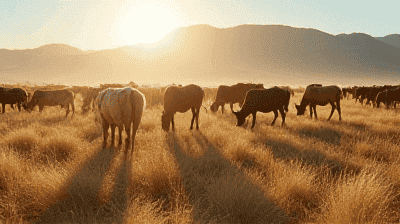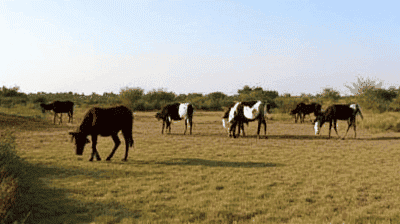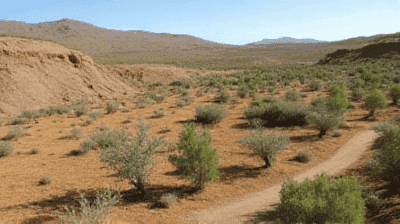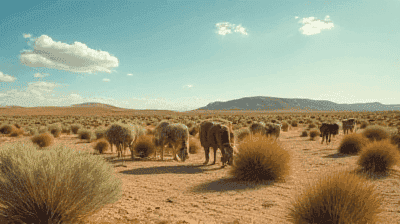
Desertification is one of the most pressing environmental issues facing the planet today. As arid and semi-arid lands become increasingly degraded due to factors like unsustainable land management, climate change, and overgrazing, the resilience of these ecosystems diminishes, leading to a cascade of ecological and socioeconomic problems. However, regenerative ranching offers a promising solution to combat desertification. This holistic approach to grazing not only focuses on the sustainable management of livestock but also seeks to restore degraded land by improving soil health, increasing biodiversity, and enhancing the resilience of ecosystems.
Desertification refers to the process by which fertile land becomes increasingly arid and less productive, often resulting in the spread of deserts. It is characterized by the loss of vegetative cover, soil degradation, and a decline in biodiversity. While desertification is most commonly associated with dryland areas, it can occur in any region where human activities adversely affect the land.
Several factors contribute to desertification, including:
Overgrazing: Excessive grazing pressure from livestock can lead to the depletion of vegetation, exposing soil to erosion and degradation.
Deforestation: Clearing forests for agriculture or urban development removes protective vegetation, increasing erosion and destabilizing local ecosystems.
Climate Change: Changes in temperature, precipitation patterns, and extreme weather events can exacerbate land degradation, reducing the resilience of ecosystems.
Unsustainable Agricultural Practices: Practices such as monocropping, excessive fertilizer use, and inadequate crop rotation can degrade soil quality and diminish its productivity.
Urbanization: Land conversion for housing and infrastructure can disrupt natural processes and contribute to the fragmentation of ecosystems.
The consequences of desertification are profound and far-reaching, affecting not only the environment but also human livelihoods:
Loss of Biodiversity: Degraded landscapes often lead to reduced habitats for plants and animals, contributing to declines in biodiversity.
Food Insecurity: As agricultural productivity declines, communities may face food shortages and increased reliance on external food sources.
Water Scarcity: Degraded soils are less able to retain water, leading to diminished water supplies and increased competition for this vital resource.
Economic Strain: Loss of arable land can drive rural communities into poverty, leading to migration and social instability.
Climate Change Feedback: Land degradation reduces the soil's capacity to sequester carbon, exacerbating global climate change impacts.

Grazing has been a fundamental part of land use for millennia, providing food and livelihood for millions. However, when managed poorly, grazing can lead to severe land degradation:
Overgrazing: This occurs when livestock numbers exceed the carrying capacity of the land, leading to vegetation loss and soil erosion.
Mismanagement of Grazing Patterns: Continuous grazing in one area can prevent vegetation recovery, lead to soil compaction, and create desert-like conditions.
Not all grazing practices are detrimental. When properly managed, grazing can play a role in promoting healthy ecosystems:
Nutrient Cycling: Livestock contribute to nutrient cycling through their manure, which can enhance soil fertility and promote plant growth.
Vegetation Control: Grazing can help manage invasive species and control the growth of unwanted vegetation, allowing native species to thrive.
Soil Aeration: The movement of livestock can help break up compacted soil, promoting water infiltration and root growth.
Regenerative ranching is an approach to livestock management that seeks to restore and enhance the health of ecosystems. It emphasizes the importance of holistic management and focuses on the following principles:
Soil Health: Prioritizing practices that enhance soil structure, organic matter content, and biological activity.
Biodiversity: Encouraging biodiversity at both the plant and animal levels to create resilient ecosystems.
Planned Grazing: Implementing rotational grazing and other strategies to optimize livestock impact and promote recovery of grasslands.
Water Management: Implementing practices that improve water retention, reduce erosion, and enhance watershed health.
Community Involvement: Engaging local communities in decision-making and management processes to promote sustainable practices.
Holistic Planned Grazing: This practice involves designing grazing systems that consider the timing, intensity, and duration of grazing events, allowing for the recovery of pastures and minimizing soil degradation.
Cover Cropping: Planting cover crops during the off-season helps prevent soil erosion, improves soil structure, and enhances biodiversity.
Agroforestry: Integrating trees into grazing systems creates multifunctional landscapes that support livestock, enhance biodiversity, and improve soil health.
Water Harvesting: Techniques such as building swales and check dams help to retain water on the land, improving irrigation efficiency and enhancing drought resilience.
Organic Fertilization: Utilizing compost and organic fertilizers to improve soil fertility and health, reducing dependency on synthetic inputs.

The Savory Institute: Founded by Allan Savory, the institute promotes holistic management practices and has documented numerous case studies where regenerative ranching has successfully reversed land degradation. In places like Namibia, holistic planned grazing has restored biodiversity and increased water retention.
The Kalahari Desert: In this semi-arid region, innovative grazing practices have helped communities restore degraded lands by managing livestock through rotational grazing, resulting in improved vegetation cover and soil health.
The Great Plains, USA: Ranchers implementing regenerative practices such as managed grazing and soil amendment have reported enhanced grassland productivity and increased resilience to drought conditions.
Regenerative ranching offers several mechanisms by which it can combat desertification:
Improved Soil Structure: Through practices like cover cropping and reduced tillage, regenerative ranching enhances soil health, improving its ability to retain water and nutrients.
Enhanced Carbon Sequestration: Healthy soils can sequester significant amounts of atmospheric carbon, mitigating climate change while improving soil fertility.
Restoration of Native Vegetation: By allowing for the recovery of native species and reducing the prevalence of invasives, regenerative practices can enhance biodiversity and ecosystem stability.
Increased Water Retention: Building soil organic matter and structure creates more porous soils that absorb and retain water, reducing runoff and erosion.
Community Resilience: By supporting local livelihoods and enhancing ecosystem services, regenerative ranching builds resilience against environmental and economic shocks.
Transitioning to regenerative ranching can involve upfront costs and risks that may deter ranchers:
Initial Investment: Establishing new infrastructure and adopting new practices can require significant financial resources.
Market Access: Farmers may struggle to access markets that reward sustainable practices, resulting in economic uncertainty.
Many ranchers lack access to information about regenerative practices and may be resistant to change:
Limited Availability of Resources: Educational programs and resources on regenerative ranching are often scarce, particularly in rural regions.
Cultural Resistance: Long-standing traditions and practices can create resistance to new methods that challenge established norms.
Climate change introduces unpredictability, making it difficult for ranchers to plan for the future:
Extreme Weather Events: Increasing frequency and severity of droughts, floods, and storms can disrupt grazing practices and affect yields.
Market Fluctuations: Changes in commodity prices may influence the viability of adopting regenerative practices.

Effective policy measures can encourage the adoption of regenerative ranching practices:
Subsidies for Sustainable Practices: Providing financial incentives for ranchers who implement regenerative practices can offset initial costs and encourage participation.
Access to Technical Assistance: Offering support through extension services can help ranchers acquire knowledge about regenerative practices and implement them effectively.
Research Funding: Investing in research to evaluate the effectiveness of regenerative practices can help establish evidence-based guidelines for ranchers.
Policies that promote sustainable land management are essential for combating desertification:
Land Tenure Security: Ensuring that ranchers have secure land rights encourages investment in regenerative practices and long-term stewardship.
Integrated Land Use Planning: Coordinating land use at regional levels ensures that grazing practices align with conservation efforts and ecosystem restoration.
Grassroots involvement is key to the success of regenerative ranching:
Collaboration with NGOs: Building partnerships with non-governmental organizations can enhance knowledge sharing and community engagement in sustainable practices.
Facilitating Knowledge Exchange: Organizing workshops and field days where ranchers can learn from one another fosters a sense of community and encourages the spread of regenerative practices.
Innovative technologies have the potential to further enhance regenerative ranching efforts:
Soil Monitoring Technologies: Advanced soil moisture sensors and drones can provide ranchers with real-time data on soil health and moisture levels, enabling improved management practices.
Data-Driven Decision Making: Integrating big data and predictive analytics into ranching operations can help optimize grazing patterns and resource allocation.
As consumer awareness of sustainable practices grows, new market opportunities are emerging for ranchers:
Grass-Fed and Organic Labels: As demand for sustainably produced food increases, ranchers adopting regenerative practices can access premium markets that prioritize environmental responsibility.
Carbon Markets: Participating in carbon offset programs allows ranchers to monetize their contributions to carbon sequestration through regenerative practices.
Education and advocacy efforts will be crucial in promoting regenerative ranching:
Community Workshops: Local workshops on regenerative practices can empower ranchers with the knowledge and confidence to implement sustainable methods.
Advocacy Campaigns: Collaborating with environmental organizations to raise awareness about the benefits of regenerative ranching can foster public support and encourage policy change.
The challenge of desertification requires collective efforts and innovative solutions that embrace sustainability and resilience. Regenerative ranching presents a compelling approach with the potential to reverse land degradation, restore ecosystems, and enhance livelihoods in arid environments.
By harnessing the principles of regenerative ranching—such as planned grazing, soil health improvement, and community engagement—ranchers can combat desertification while promoting biodiversity and ecosystem resilience. Despite the challenges, strong policy support, technological innovations, and community involvement can pave the way for a more sustainable future.
Investing in regenerative ranching not only contributes to the health of the planet but also secures a viable future for agricultural communities facing the threat of land degradation. As we work to protect our ecosystems, embracing processes that enhance the interconnectedness between grazing and environmental restoration will be essential in building a sustainable world for generations to come.